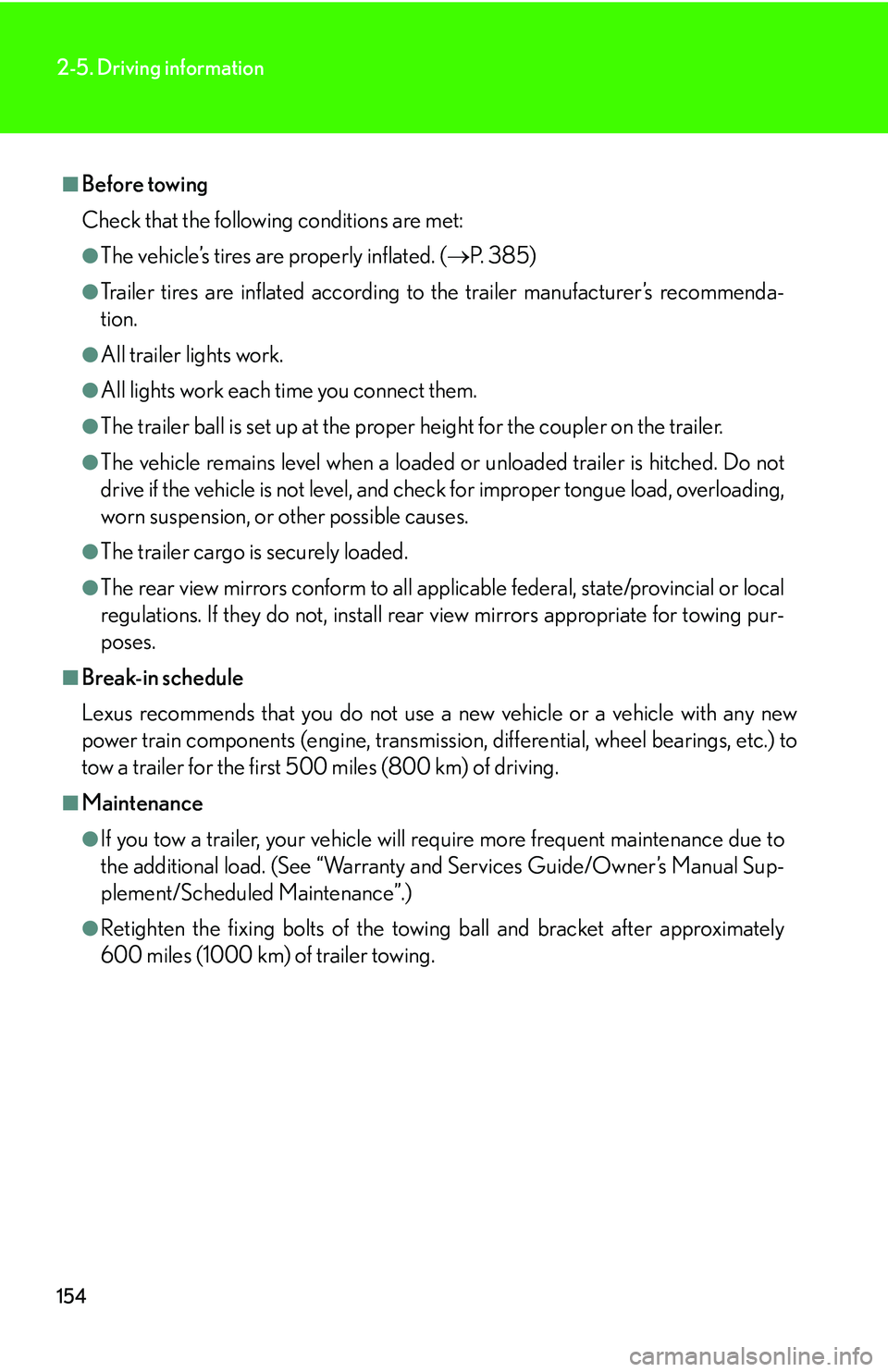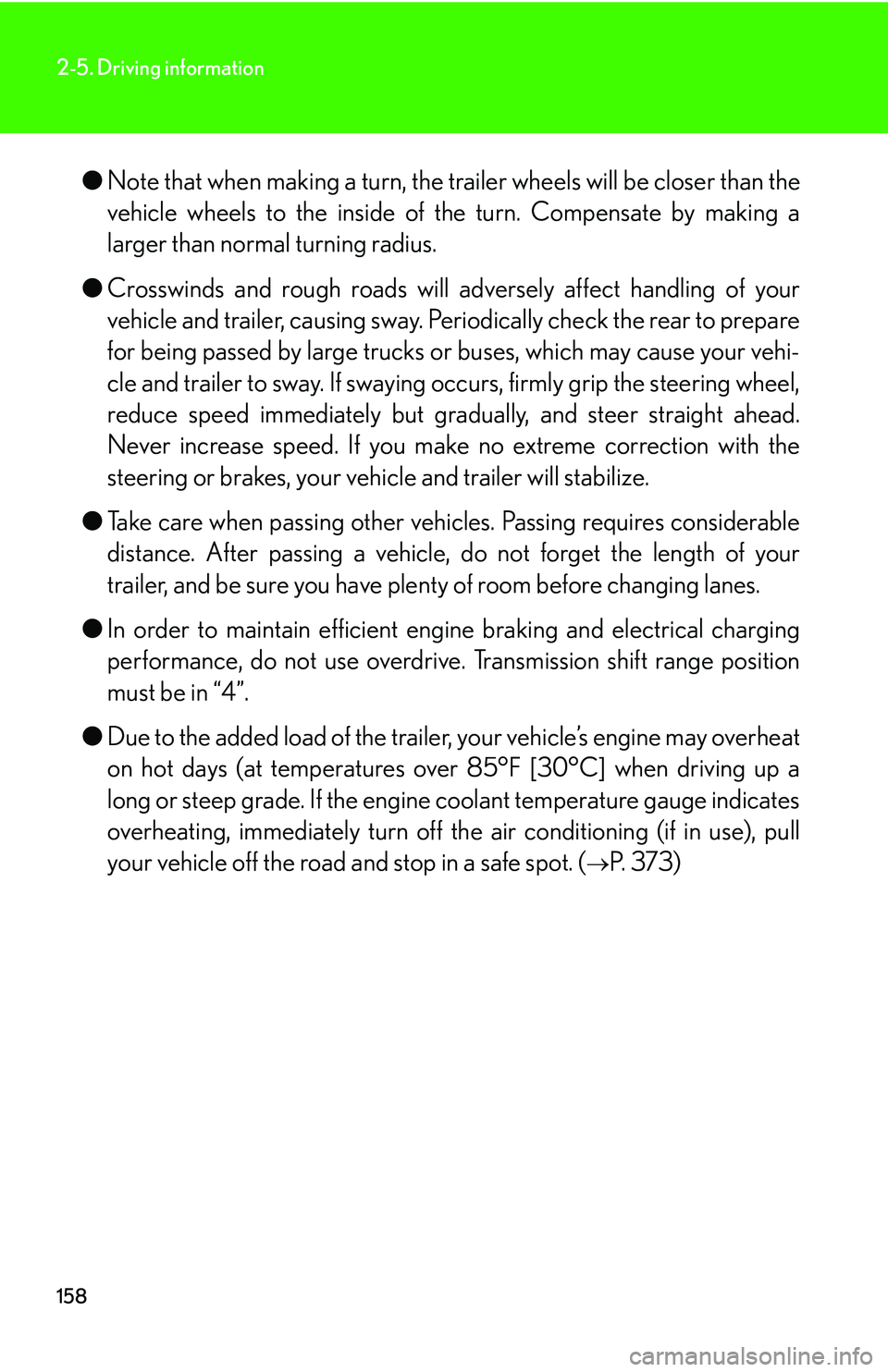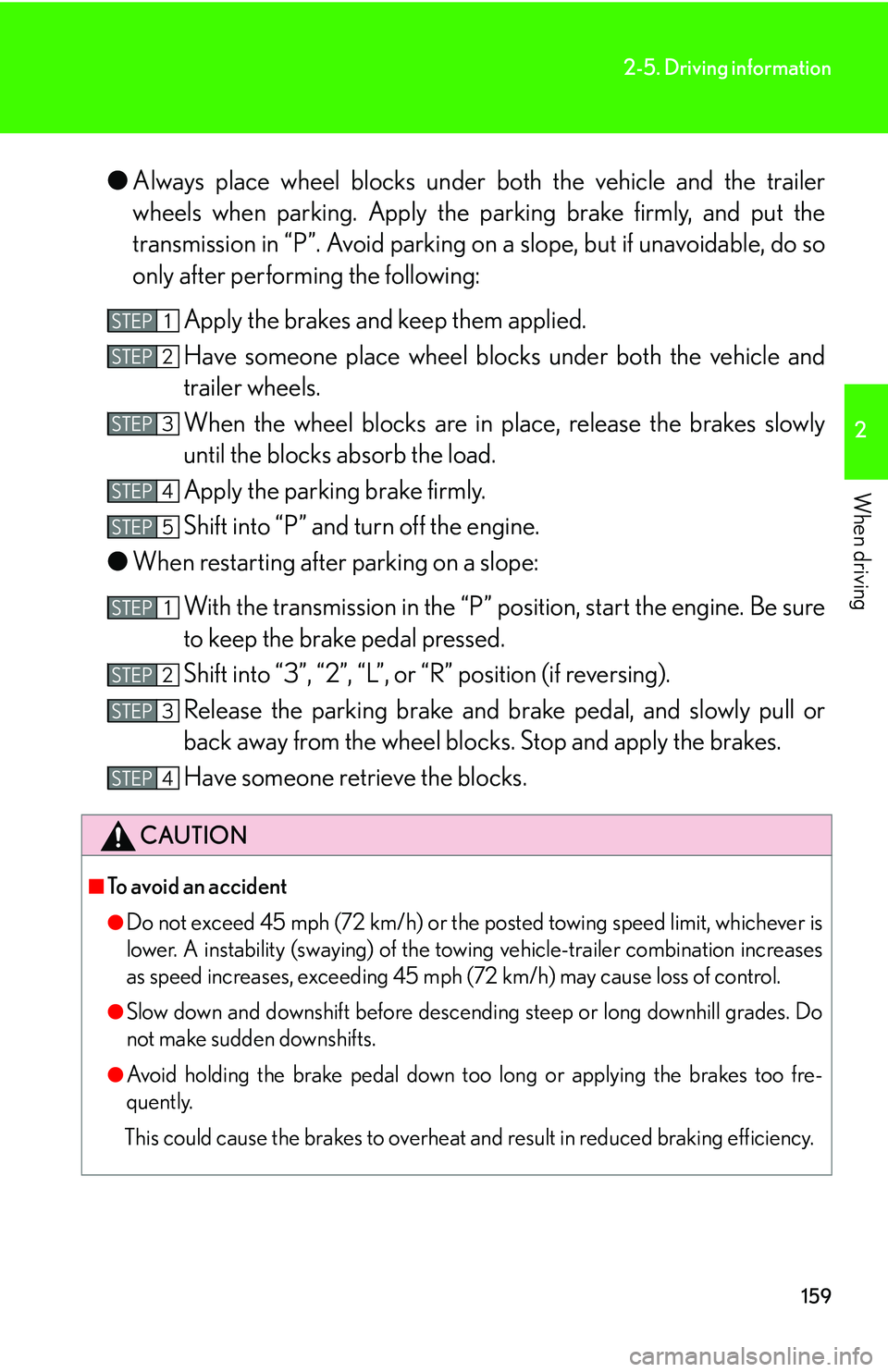Lexus GX470 2007 Instrument cluster / LEXUS 2007 GX470 OWNER'S MANUAL (OM60C64U)
Manufacturer: LEXUS, Model Year: 2007, Model line: GX470, Model: Lexus GX470 2007Pages: 436, PDF Size: 11.52 MB
Page 171 of 436

151
2-5. Driving information
2
When driving
Towing a trailerContact your Lexus dealer for furt her information about additional
requirements such as a towing kits, etc.
Hitch and tow hitch receiver
â– Hitch
Trailer hitch assemblies have differen t weight capacities established by
the hitch manufacturer. Even though the vehicle may be rated for tow-
ing a higher weight, the operator must never exceed the maximum
weight rating specified for the trailer hitch.
â– Trailer tongue load
The trailer cargo load should be d istributed so that the tongue load
is 9 to 11% for weight carrying hitch or 15% for we ight distributing
hitch of the total trailer weight, not exceeding the following.
Weight carrying hitch: 650 lb. (294 kg)
Weight distributing hitch: 975 lb. (442 kg)
(Tongue load/Total trailer weight x 100 = 9 to 11% or 15%)
The total trailer weight and tongue load can be measured with plat-
form scales found at a highway we ighing stations, building supply
companies, trucking companies, junk yards, etc.
Total trailer weight
Tongue load
Page 172 of 436

152
2-5. Driving information
â– Tow hitch receiver
A tow hitch receiver installed
under the rear bumper is rated for
weight that does not exceed the
vehicle’s total towing weight.
Selecting trailer ball
Use the correct trailer ball for your application. Trailer ball load rating
Matches or exceeds the gross
trailer weight rating of the trailer.
Ball diameter
Matches the size of the trailer cou-
pler. Most couplers are stamped
with the required trailer ball size.
Shank length
Protrudes beyond the bottom of
the lock washer and nut at least 2
threads.
Shank diameter
Matches the ball mount hole diam-
eter size.
Page 173 of 436

153
2-5. Driving information
2
When driving
Connecting trailer lightsUse the wire harness stored in the rear end underbody.
â– When connecting and disconnecting a trailer
Connecting Set the rear height control air suspension to “LO” mode.
Turn off the ignition switch or the rear height control air suspension.
Connect the trailer.
Turn on the switch that was turned off on STEP 2.
Set the rear height control air suspension to “N” mode.
Disconnecting Set the rear height control air suspension to “LO” mode.
Turn off the ignition switch or the rear height control air suspension.
Set the supporting leg of the trailer on the ground and raise the hitch by
4 in. (100 mm).
Turn on the switch that was turned off on STEP 2.
Wait until vehicle height is stabilized.
Make sure the hitch is disconnected. If the hitch does not disconnect, raise
the hitch higher and repeat steps 2 through 5.
Move the vehicle forward in the “LO” mode where the hitch does not
touch anything in the “N” mode.
Set the rear height control air suspension in the “N” mode.
STEP1STEP1
STEP2STEP2
STEP1STEP3STEP3
STEP1STEP4STEP4
STEP1STEP5STEP5STEP5
STEP1STEP1
STEP2STEP2
STEP1STEP3STEP3
STEP1STEP4STEP4
STEP1STEP5STEP5STEP5
STEP1STEP5STEP6STEP6STEP6
STEP1STEP5STEP6STEP7STEP7
STEP1STEP5STEP6STEP8STEP8
Page 174 of 436

154
2-5. Driving information
â– Before towing
Check that the following conditions are met:
●The vehicle’s tires are properly inflated. (P. 3 8 5 )
●Trailer tires are inflated according to the trailer manufacturer’s recommenda-
tion.
â—ŹAll trailer lights work.
â—ŹAll lights work each time you connect them.
â—ŹThe trailer ball is set up at the proper height for the coupler on the trailer.
â—ŹThe vehicle remains level when a loaded or unloaded trailer is hitched. Do not
drive if the vehicle is not level, and check for improper tongue load, overloading,
worn suspension, or other possible causes.
â—ŹThe trailer cargo is securely loaded.
â—ŹThe rear view mirrors conform to all applicable federal, state/provincial or local
regulations. If they do not, install rear view mirrors appropriate for towing pur-
poses.
â– Break-in schedule
Lexus recommends that you do not use a new vehicle or a vehicle with any new
power train components (engine, transmission, differential, wheel bearings, etc.) to
tow a trailer for the first 500 miles (800 km) of driving.
â– Maintenance
â—ŹIf you tow a trailer, your vehicle will require more frequent maintenance due to
the additional load. (See “Warranty and Services Guide/Owner’s Manual Sup-
plement/Scheduled Maintenance”.)
â—ŹRetighten the fixing bolts of the towing ball and bracket after approximately
600 miles (1000 km) of trailer towing.
Page 175 of 436

155
2-5. Driving information
2
When driving
CAUTION
â– To avoid accident or injury
â—ŹThe total trailer weight (trailer weight plus the weight of cargo) must not exceed
6500 lb. (2948 kg).
â—ŹIf a trailer and cargo weight over 2000 lb. (907 kg), use a sway control device
with sufficient capacity.
â—ŹThe gross combined weight (sum of your vehicle weight plus its load and the total
trailer weight) must not exceed 12000 lb. (5443 kg).
â—ŹDo not exceed the trailer hitch assembly weight, gross vehicle weight, gross axle
weight and trailer tongue load capacities.
â—ŹNever load more weight in the back than in the front of the trailer. About 60% of
the load should be in the front half of the trailer, and the remaining 40% in the
rear.
●Set the vehicle height to the “LO” mode and turn off the rear height control air
suspension to prevent the vehicle he ight from automatically changing.
â—ŹThe tow hitch receiver installed on your vehicle must never be used on another
vehicle
â– Hitches
â—ŹIf you wish to install a trailer hitch, contact your Lexus dealer.
â—ŹUse only a hitch that conforms to the total trailer weight requirement.
â—ŹFollow the directions supplied by the hitch manufacturer.
â—ŹLubricate the hitch ball with a light coat of grease.
â—ŹRemove the trailer hitch whenever you are not towing a trailer. After removing
the hitch, seal any mounting hole in the vehicle body to prevent entry of any sub-
stances into the vehicle.
â– When towing a trailer
â—ŹIf the total trailer weight exceeds 1000 lb . (453 kg), trailer brakes are required.
●Never tap into your vehicle’s hydraulic system, as this will lower the vehicle’s brak-
ing effectiveness.
â—ŹNever tow a trailer without using a safety chain securely attached to both the
trailer and the vehicle. If damage occurs to the coupling unit or hitch ball, there is
danger of the trailer wandering into another lane.
Page 176 of 436

156
2-5. Driving information
NOTICE
â– When installing a trailer hitch
â—ŹUse only the position recommended by your Lexus dealer. Do not install the
trailer hitch on the bumper; this may cause body damage.
â—ŹDo not use axle-mounted hitches, as they can cause damage to the axle housing,
wheel bearings, wheels or tires.
â– Brakes
Lexus recommends trailers with brakes that conform to all applicable federal and
state/provincial regulations.
â– Safety chain
A safety chain must always be used between the towing vehicle and the trailer.
Leave sufficient slack in the chain for turns. The chain should cross under the trailer
tongue to prevent the tongue from droppi ng to the ground in the case that it
becomes damaged or separated. For the correct safety chain installation proce-
dure, ask your Lexus dealer.
â– Do not directly splice trailer lights
Directly splicing trailer lights may dama ge your vehicle’s electrical system and
cause a malfunction.
Page 177 of 436

157
2-5. Driving information
2
When driving
Trailer towing tipsYour vehicle will handle differently when towing a trailer. The 3 main
causes of vehicle-trailer accidents are driver error, excessive speed and
improper trailer loading. Keep the following in mind when towing.
â—Ź Before starting out, check the trai ler lights and the vehicle-trailer con-
nections. Recheck after driving a short distance.
â—Ź Practice turning, stopping and reversing with the trailer attached in an
area away from traffic until you be come accustomed to the feel of the
vehicle.
â—Ź Reversing with a trailer attached is difficult and requires practice Grip
the bottom of the steering wheel and move your hand to the left to
move the trailer to the left. Move yo ur hand to the right to move the
trailer to right. (This is generally opposite to reversing without a trailer
attached.) Avoid sharp or prolon ged turning. Have someone guide
you when reversing to reduce the risk of an accident.
â—Ź As stopping distance is increased when towing a trailer, vehicle-to-
vehicle distance should be increas ed. For each 10 mph (16 km/h) of
speed, allow at least one vehicle and trailer length.
â—Ź Avoid sudden braking as you may sk id, resulting in jackknifing and loss
of control. This is especially true on wet or slippery surfaces.
â—Ź Avoid jerky starts or sudden acceleration.
â—Ź Avoid jerky steering and sharp turn s, and slow down before making
turns.
Page 178 of 436

158
2-5. Driving information
â—ŹNote that when making a turn, the tr ailer wheels will be closer than the
vehicle wheels to the inside of the turn. Compensate by making a
larger than normal turning radius.
â—Ź Crosswinds and rough roads will ad versely affect handling of your
vehicle and trailer, causing sway. Periodically check the rear to prepare
for being passed by large trucks or buses, which may cause your vehi-
cle and trailer to sway. If swaying occurs, firmly grip the steering wheel,
reduce speed immediately but grad ually, and steer straight ahead.
Never increase speed. If you make no extreme correction with the
steering or brakes, your vehi cle and trailer will stabilize.
â—Ź Take care when passing other vehi cles. Passing requires considerable
distance. After passing a vehicle, do not forget the length of your
trailer, and be sure you have plenty of room before changing lanes.
â—Ź In order to maintain efficient eng ine braking and electrical charging
performance, do not use overdrive. Transmission shift range position
must be in “4”.
● Due to the added load of the trailer, your vehicle’s engine may overheat
on hot days (at temperatures over 85°F [30°C] when driving up a
long or steep grade. If the eng ine coolant temperature gauge indicates
overheating, immediately turn off th e air conditioning (if in use), pull
your vehicle off the road and stop in a safe spot. (
ď‚®P. 373)
Page 179 of 436

159
2-5. Driving information
2
When driving
â—ŹAlways place wheel blocks under both the vehicle and the trailer
wheels when parking. Apply the pa rking brake firmly, and put the
transmission in “P”. Avoi d parking on a slope, but if unavoidable, do so
only after performing the following:
Apply the brakes and keep them applied.
Have someone place wheel blocks under both the vehicle and
trailer wheels.
When the wheel blocks are in pl ace, release the brakes slowly
until the blocks absorb the load.
Apply the parking brake firmly.
Shift into “P” and turn off the engine.
â—Ź When restarting after parking on a slope:
With the transmission in the “P” position, start the engine. Be sure
to keep the brake pedal pressed.
Shift into “3”, “2”, “L”, or “R” position (if reversing).
Release the parking brake and br ake pedal, and slowly pull or
back away from the wheel blocks. Stop and apply the brakes.
Have someone retrieve the blocks.
CAUTION
â– To avoid an accident
â—ŹDo not exceed 45 mph (72 km/h) or the posted towing speed limit, whichever is
lower. A instability (swaying) of the towing vehicle-trailer combination increases
as speed increases, exceeding 45 mph (72 km/h) may cause loss of control.
â—ŹSlow down and downshift before descending steep or long downhill grades. Do
not make sudden downshifts.
â—ŹAvoid holding the brake pedal down too long or applying the brakes too fre-
quently.
This could cause the brakes to overheat and result in reduced braking efficiency.
STEP1STEP1
STEP2STEP2
STEP1STEP3STEP3
STEP1STEP4STEP4
STEP1STEP5STEP5STEP5
STEP1STEP1
STEP2STEP2
STEP1STEP3STEP3
STEP1STEP4STEP4
Page 180 of 436

160
2-5. Driving information
Dinghy towing
NOTICE
â– To avoid serious damage to your vehicle
Do not tow your vehicle with four wheels on the ground.
Your vehicle is not designed to be dinghy towed (with 4 wheels on the
ground) behind a motor home.